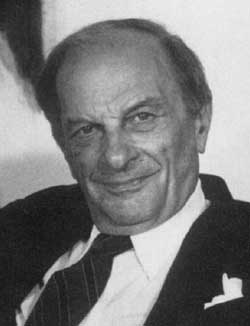 |
Stanislaw Ulam, the Hydrogen Bomb...
and Nuclear Saucers
Stanislaw Ulam was a Polish mathematician who came to the US in the 1930s on John von Neumann's recommendation and participated in the development of the first nuclear weapons at Los Alamos during WWII. When interest in bombs based on thermonuclear fusion began to grow in the late 1940s, Ulam returned to the New Mexico laboratory as a member of Edward Teller's "Super" working group, which was attempting to solve the seemingly intractible fusion problem.
By all accounts, the partnership was not a smooth one, given Teller's famous temperament and ego. But by early 1951, the two scientists had devised a configuration of nuclear and chemical materials that would prove to be an extremely efficient means of igniting a fusion reaction.
As John McPhee elegantly explains in The Curve of Binding Energy, one of the more important advances in nuclear weapons design in the post-war period involved a principle called "levitation," an improvement on the original implosion technology used in the "Trinity Gadget" and the Fat Man bomb that had destroyed Nagasaki. In the Fat Man implosion design, the high explosive shell and a heavy "tamper" material had rested in direct contact with the plutonium sphere at the center of the bomb. In the levitated concept, a gap between outer and inner portions of the nuclear core allowed the imploding shell to accelerate to tremendous speed before striking the nuclear material, greatly improving the compression of the core and the efficiency of the ensuing nuclear reactions.
These phenomena are called "hydrodynamic " processes, and in studying them, and similar ones that would be required to ignite a fusion reaction in a hydrogen bomb, the Los Alamos designers developed techniques for transforming explosive energy into precisely controlled momentum - steering shock waves, channeling radiation, controlling superheated gases, modulating the huge energies released in a nuclear reaction.
As early as 1944, Ulam and other Los Alamos researchers had begun to consider the use of nuclear energy as a means of propelling aircraft and rockets. In 1946 he produced rough calculations on a specialized version of this technology - means by which fission explosions external to a vehicle could be turned into propulsive thrust - and in 1947 Ulam and his associate Frederick Reines issued a memorandum describing this concept in somewhat greater detail. The basic idea was closely tied to the work on the physics of the levitated bomb core and employed many of the same essential techniques.
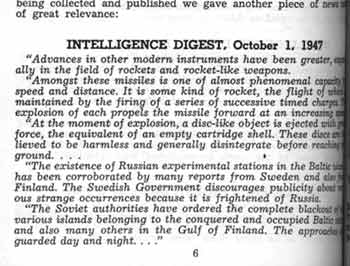 |
Weirdly, a private civilian journal called "Intelligence Digest," published by British conservative figure Kenneth DeCourcy, described in an October 1947 item a "pulse-powered rocket" that sounds strangely similar to Ulam's concept. In all probability a coincidence, it is most intriguing. |
By the mid-1950s, fission bomb technology had advanced to the point where very small, specialized, and relatively inexpensive nuclear devices were feasible. At the same time, it was becoming apparent that the military would eventually need an efficient way to lift enormous payloads into space. In the summer of 1955 Ulam and Cornelius J. Everett produced a more formal study on the possibility of actually using nuclear explosions as a source of propulsive energy for a space vehicle.
...which happened (for sound scientific reasons) to be "saucer-shaped."
[Note: the linked PDF document is copied from the original report which until recently could be downloaded from the Los Alamos National Laboratory Research Library URL cited in the notes following this article. However, Post September 11, 2001 security restrictions have now made the original document inaccessible.]
Los Alamos Report LAMS-1955
On A Method of Propulsion of Projectiles By Means of External Nuclear Explosions
C J Everett and S M Ulam
August 1955
(Secret)
...The scheme proposed in the present report involves the use of a series of expendable reactors (fission bombs) ejected and detonated at a considerable distance from the vehicle, which liberate the required energy in an external âmotorâ consisting essentially of empty space. The critical question about such a method concerns its ability to draw on the real reserves of nuclear power liberated at bomb temperatures without smashing or melting the vehicle. General proposals of this sort were first made by S. Ulam in 1946, and some preliminary calculations were made by F. Reines and S. Ulam in a Los Alamos memorandum dated 1947. More recently, an additional idea was advanced, which consists in placing between each bomb and the rocket a âpropellantâ consisting of water or some plastic, which will be heated by the bomb, and which will propel the vehicle during its subsequent explosive expansion. Some of the advantages of this proposal will be mentioned in the final section. In any such device, one of the principal difficulties is the heating of the rocket by the propellant. We seem to encounter a situation in which the base of the rocket will be, periodically, at one second intervals, in the proximity of a very hot gas for durations of one millisecond each. Study of the effects of such a variable wall temperature on various materials will be made, and reported on subsequently.
The most recent idea is that the use of a sufficiently powerful magnetic field shielding the base of the rocket will have the effect of reflecting the (ionized) atoms of the hot propellant gas before they reach the rocket, thus avoiding heating of the base and incidentally gaining a factor on momentum transfer. It is hoped that this possibility also may be investigated at least schematically and reported on in Part II. However, there appear to be many difficulties in such a study, involving the reaction of a plasma to the magnetic field. Whether the field strength required is impractically large remains to be seen. There is, it seems, the possibility of the formation of a powerful plasma current at the base of the rocket and a pinch effect, which may mean that the magnetic field becomes compressed to a smaller volume and the magnetic pressure considerably increased.
... In order to gain some quantitative insight into the elements of such a system, we propose to adopt a particular set of assumptions and to study numerically the effect of variation of parameters. The [equations] which follow are obviously highly tentative and subject to many questions here unresolved. The vehicle is considered to be saucer-shaped, of diameter about 10 meters, sufficient at any rate to intercept all or most of the exploding propellant. Its final mass Mf is perhaps 12 tons, which must cover structure, payload, instruments, storage for propellant and bombs, and, if required, apparatus for maintaining the magnetic field. The initial mass Mo of the vehicle exceeds this by the mass of bombs and propellant.
The bombs are ejected at something like one second intervals from the base of the rocket and are detonated at a distance of some 50 meters from the base. Synchronized with this, disk-shaped masses of propellant are ejected in such a way that the rocket-propellant distance is about 10 meters at the instant the exploding bomb hits it. The propellant is raised to high temperature, and, in expanding, transmits momentum to the vehicle. The final velocity Vf is attained after N (~50) such explosions...
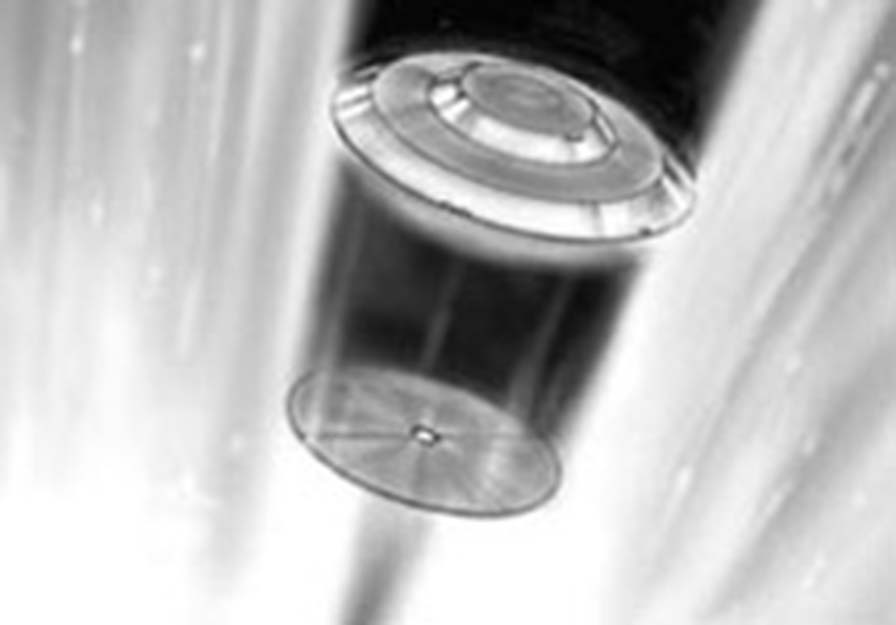 |
Ulam's saucer during boost. Bomb and plastic propellant disk have just been ejected, previous bomb has just detonated
© Joel Carpenter 1999 |
The arrangement of the components seems to have resembled an inside-out implosion weapon: the debris from the ejected bomb would strike the plastic propellant disc - the counterpart of the tamper in the implosion bomb - and turn it into cloud of expanding plasma, or ionized gas. This plasma would accelerate across the ten-meter gap and slam into the spacecraft, transferring its momentum to the vehicle in much the same way that the tamper of the bomb had compressed its plutonium core, and would do it uniformly, without blowing the spacecraft apart. But in this case, the direction of motion was outward - and upward. Only fifty-odd pulses would be sufficient to drive the vehicle (which would be carried above most of the atmosphere by a conventional rocket) to escape velocity.
Ulam's concept led to still-classified studies of nuclear pulse-powered space launchers for the Air Force, and to Project Orion, a serious attempt to design, circa 1963-4, a similar spacecraft for NASA interplanetary missions. The image below shows a miniature flying prototype of the Orion vehicle - built by General Atomic, a company founded by Teller's protege Frederick de Hoffmann - which made a successful flight to an altitude of about 100 meters in November 1959, during which it ejected several small conventional explosive charges in rapid succession.
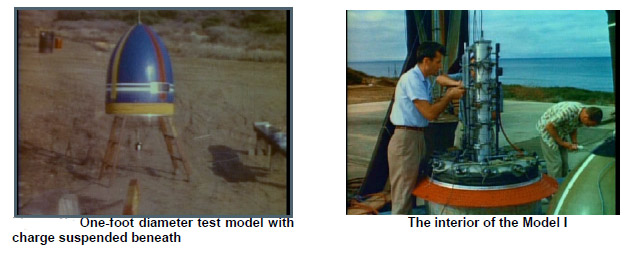 |
Orion "Putt-Putt" test vehicle |
By the early 1960s, General Atomic had advanced the Orion concept to studies of a vehicle capable of sending a crewed expedition to Mars. This vehicle was sized to the diameter of the Saturn V rocket and was to be launched in several sections and assembled in Earth orbit. A Mars mission of several months duration with a crew of eight was planned. Landing on Mars was to be accomplished by an advanced lifting-body vehicle.
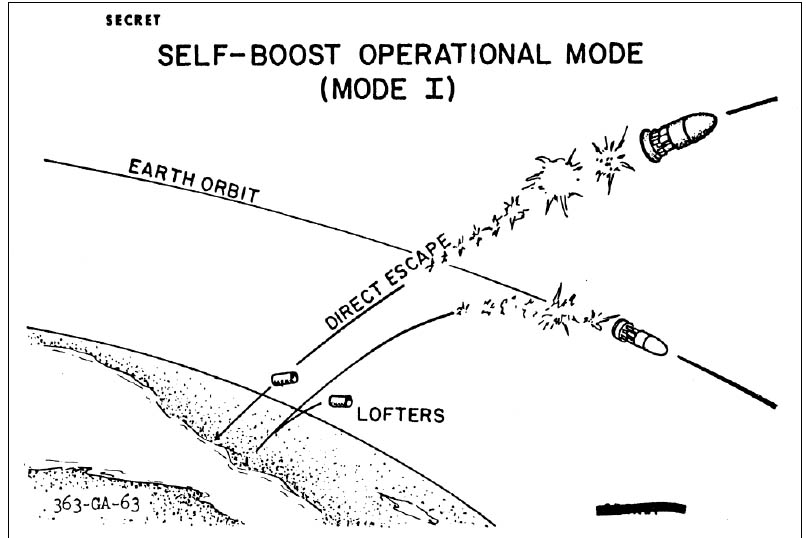 |
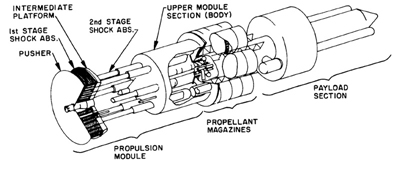 |
| Mars Orion during chemical rocket boost of nuclear engine into orbit, where additional launches build-up the payload and propellant re-supply before the nuclear pulse engine would start. | Mars Orion schematic diagram (General Atomic via Aerospace Projects Review) |
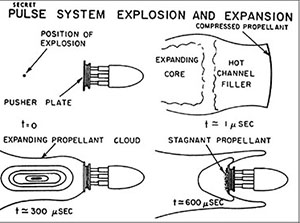 |
Mechanism to eject "pulse units" (small nuclear bombs)
General Atomic via Aerospace Projects Review |
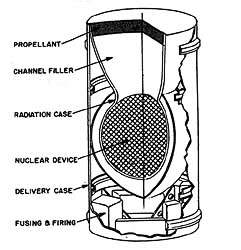 |
Nuclear "pulse unit" of around .25 kiloton yield. Hundreds of these bombs would be used to accelerate Orion to interplanetary speeds
General Atomic via Aerospace Projects Review |
Sources
(Note: This article was written prior to the publication of the definitive history of the Orion project, George Dyson's fascinating Project Orion: The True Story of the Atomic Spaceship (New York: Henry Holt and Co, 2002))
Brower, Kenneth, The Starship and the Canoe (New York: Harper and Row, 1978)
Everett, C J and Stanslaw Ulam, LAMS-1955: On A Method of Propulsion of Projectiles By Means of External Nuclear Explosions
(Los Alamos National Laboratory Research Library PDF document)
Hansen, Chuck, US Nuclear Weapons: The Secret History (Arlington, TX: Aerofax, Inc, 1988)
Longmire, C, F Reines and S Ulam, LAMS-2186: Some Schemes for Nuclear Propulsion
(Los Alamos National Laboratory Research Library PDF document)
Lowther, Scott, "Project Orion: Baseline Design," Aerospace Projects Review, Vol 1, No 4, July-August 1999
McPhee, John, The Curve of Binding Energy (New York: Farrar, Straus and Giroux, 1974)
Rhodes, Richard, Dark Sun: The Making of the Hydrogen Bomb (New York: Simon and Schuster, 1995)
Sublette, Carey, "Engineering and Design of Nuclear Weapons," Nuclear Weapons FAQ